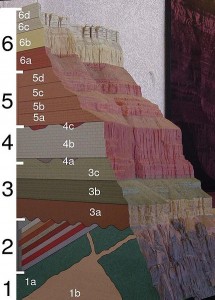The crust of the Earth is composed of a complex mix of rock types formed in specific depositional environments. Most of your everyday experience occurs in erosional environments, places where the surface of the Earth is being eroded away by physical or chemical processes. Rocks underfoot are being broken up then transported as sediments to other areas. The Grand Canyon is a good example of a river cutting through the layers of rock, exposing those layers, and transporting the rock away—piece by piece.

A cross section model of the Grand Canyon showing the rock layers and how they are broken into recognized formations.
Where is that material going? It is transported to places where it is deposited, depositional environments, where the sediments accumulate. Given enough time and protection from further weathering, those newly deposited sediments can become the sedimentary rocks of the future. The deposition of sediment occurs in a wide variety of environments such as in oceans, rivers, ponds and the like.
If we look at the rocks on the surface of the Earth today, we can see differences in their color, texture, composition, and so on. We see layering as one rock type gives way to another. Geologists map these layers to trace out the history of the Earth, as each change in rock type represents a change in the environment that created it. So each outcropping of rock represents a time machine of sorts, transporting us back to the primeval environment of that spot.
A geologic formation is a formal unit, technically called a lithostratographic unit. That fancy word simply means that rocks are grouped by similar lithology, or rock type. For example, during the Late Cretaceous the last inland sea across the mid-continent of North America (a specific environment) deposited thick accumulations of chalk and shale. Today, we can lump specific sections of that collection of rock (lithology) into a single formation and call it the Niobrara Formation.
Each formation is described and named in a specific, formal way. There are rules that geologists should follow in designating specific formations (North American Commission on Stratigraphic Nomenclature, 2005). For example, each formation should have a type section designed. This type section is not unlike a type specimen mentioned in another post: it represents the standard for that formation to help others understand how it is unique.
In future posts we will explore more aspects of formations.
NORTH AMERICAN COMMISSION ON STRATIGRAPHIC NOMENCLATURE. 2005. North American Stratigraphic Code. American Association of Petroleum Geologists Bulletin, 89(11):1547-1591.
Related Post